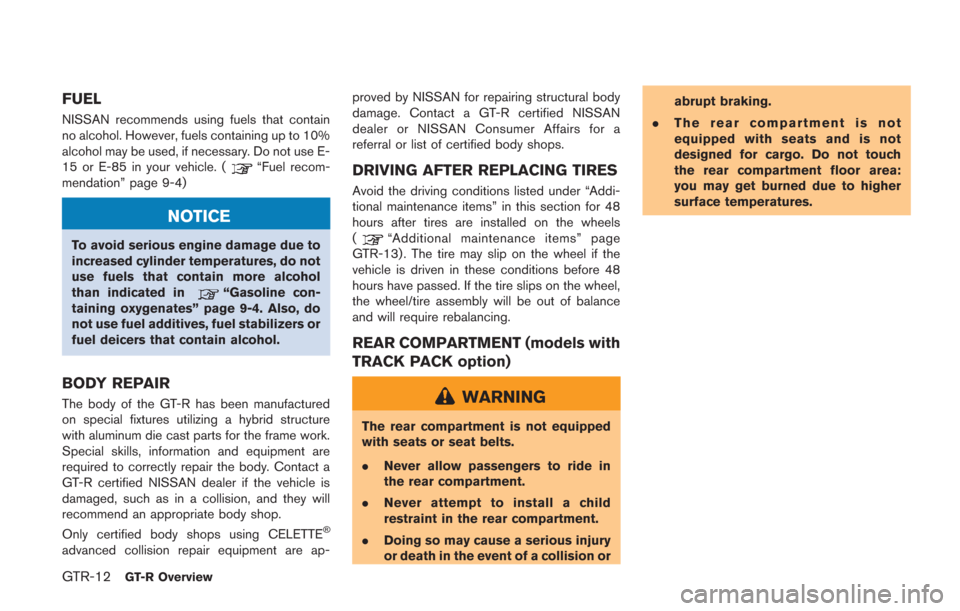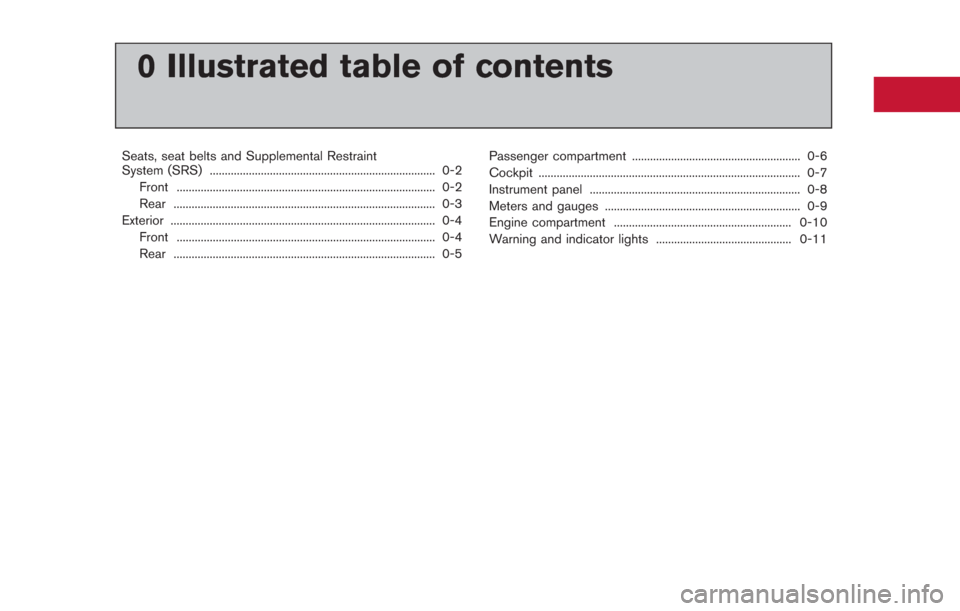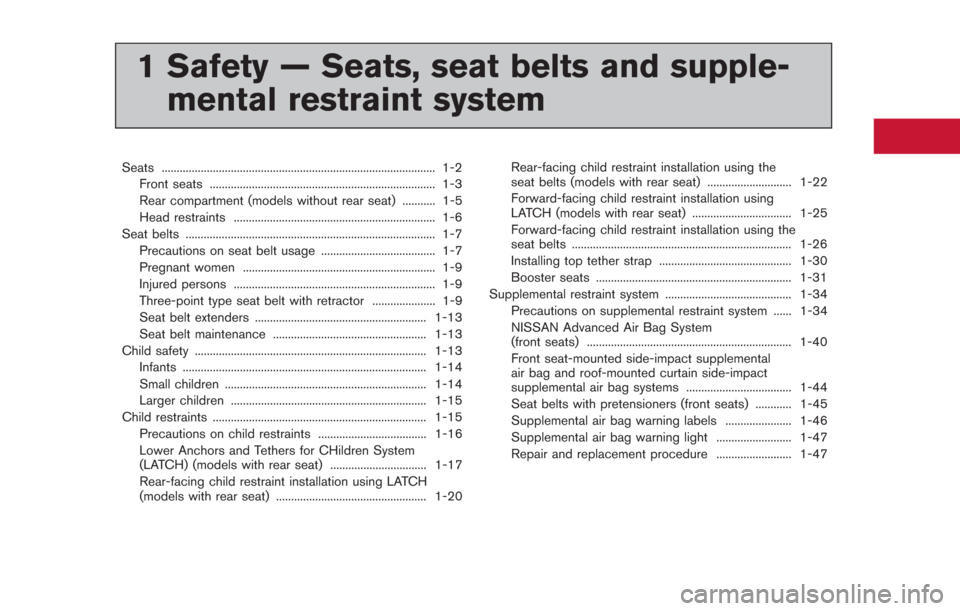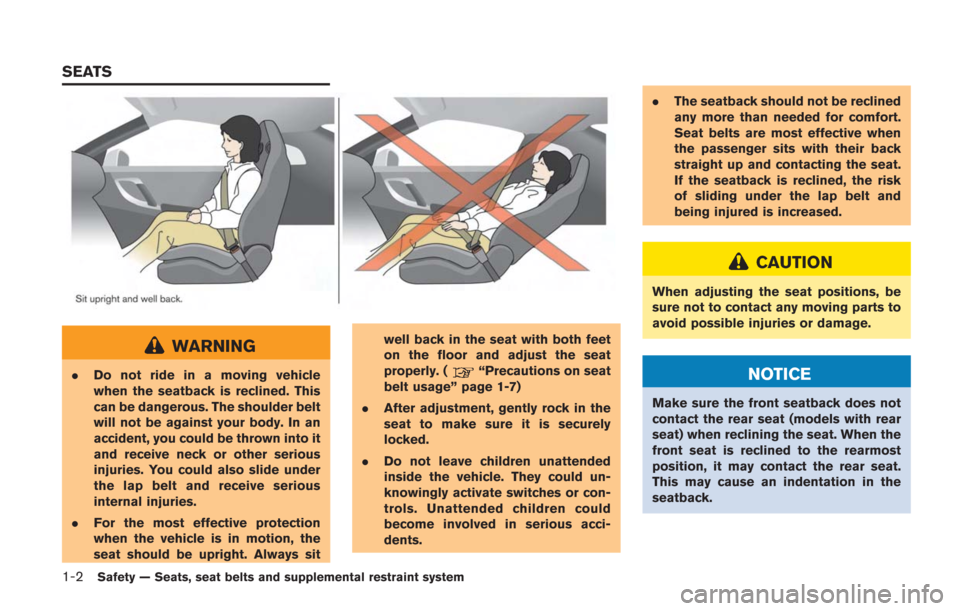Page 6 of 354
GT-R OverviewGTR
Illustrated table of contents0
Safety — Seats, seat belts and supplemental restraint system
Instruments and controls
Pre-driving checks and adjustments
Display screen, heater, air conditioner and audio systems
Starting and driving
In case of emergency
Appearance and care
Maintenance and do-it-yourself
Technical and consumer information
1
2
3
4
5
6
7
8
9
Table of
Contents
Index10
Page 19 of 354

GTR-12GT-R Overview
FUEL
NISSAN recommends using fuels that contain
no alcohol. However, fuels containing up to 10%
alcohol may be used, if necessary. Do not use E-
15 or E-85 in your vehicle. (
“Fuel recom-
mendation” page 9-4)
NOTICE
To avoid serious engine damage due to
increased cylinder temperatures, do not
use fuels that contain more alcohol
than indicated in
“Gasoline con-
taining oxygenates” page 9-4. Also, do
not use fuel additives, fuel stabilizers or
fuel deicers that contain alcohol.
BODY REPAIR
The body of the GT-R has been manufactured
on special fixtures utilizing a hybrid structure
with aluminum die cast parts for the frame work.
Special skills, information and equipment are
required to correctly repair the body. Contact a
GT-R certified NISSAN dealer if the vehicle is
damaged, such as in a collision, and they will
recommend an appropriate body shop.
Only certified body shops using CELETTE
®
advanced collision repair equipment are ap- proved by NISSAN for repairing structural body
damage. Contact a GT-R certified NISSAN
dealer or NISSAN Consumer Affairs for a
referral or list of certified body shops.
DRIVING AFTER REPLACING TIRES
Avoid the driving conditions listed under “Addi-
tional maintenance items” in this section for 48
hours after tires are installed on the wheels
(
“Additional maintenance items” page
GTR-13) . The tire may slip on the wheel if the
vehicle is driven in these conditions before 48
hours have passed. If the tire slips on the wheel,
the wheel/tire assembly will be out of balance
and will require rebalancing.
REAR COMPARTMENT (models with
TRACK PACK option)
WARNING
The rear compartment is not equipped
with seats or seat belts.
. Never allow passengers to ride in
the rear compartment.
. Never attempt to install a child
restraint in the rear compartment.
. Doing so may cause a serious injury
or death in the event of a collision or abrupt braking.
. The rear compartment is not
equipped with seats and is not
designed for cargo. Do not touch
the rear compartment floor area:
you may get burned due to higher
surface temperatures.
Page 38 of 354

0 Illustrated table of contents
Seats, seat belts and Supplemental Restraint
System (SRS) ........................................................................\
... 0-2Front ........................................................................\
.............. 0-2
Rear ........................................................................\
............... 0-3
Exterior ........................................................................\
................ 0-4 Front ........................................................................\
.............. 0-4
Rear ........................................................................\
............... 0-5 Passenger compartment ........................................................ 0-6
Cockpit ........................................................................\
............... 0-7
Instrument panel ...................................................................... 0-8
Meters and gauges ................................................................. 0-9
Engine compartment ........................................................... 0-10
Warning and indicator lights ............................................. 0-11
Page 39 of 354
0-2Illustrated table of contents
FRONT
1. Seat belt (Page 1-7)
2. Rear seat walk-in lever (P.1-5)
3. Roof-mounted curtain side-impact supplementalair bag system (P.1-34) 4. Supplemental front-impact air bags (P.1-34)
5. Seat belt pretensioner (P.1-45)
6. Front seat-mounted side-impact supplemental air
bag system (P.1-34) 7. Occupant classification sensor (pattern sensor)
(P.1-40)
8. Front seats (P.1-3)
SEATS, SEAT BELTS AND
SUPPLEMENTAL RESTRAINT
SYSTEM (SRS)
Page 40 of 354
REAR
1. Rear seats (models with rear seat)— Child restraint installation (P.1-15)
2. Child restraint anchor points (for top tether strap child restraint)* (P.1-15) 3. LATCH (Lower Anchors and Tethers for CHildren)
system (if so equipped) (P.1-17)
*: For models without rear seat, the anchor point is only available for the front passenger’s seat.
Illustrated table of contents0-3
Page 50 of 354

1 Safety — Seats, seat belts and supple-mental restraint system
Seats ........................................................................\
................... 1-2
Front seats ........................................................................\
... 1-3
Rear compartment (models without rear seat) ........... 1-5
Head restraints ................................................................... 1-6
Seat belts ........................................................................\
........... 1-7 Precautions on seat belt usage ...................................... 1-7
Pregnant women ................................................................ 1-9
Injured persons ................................................................... 1-9
Three-point type seat belt with retractor ..................... 1-9
Seat belt extenders ......................................................... 1-13
Seat belt maintenance ................................................... 1-13
Child safety ........................................................................\
..... 1-13 Infants ........................................................................\
......... 1-14
Small children ................................................................... 1-14
Larger children ................................................................. 1-15
Child restraints ....................................................................... 1-15
Precautions on child restraints .................................... 1-16
Lower Anchors and Tethers for CHildren System
(LATCH) (models with rear seat) ................................ 1-17
Rear-facing child restraint installation using LATCH
(models with rear seat) .................................................. 1-20 Rear-facing child restraint installation using the
seat belts (models with rear seat) ............................ 1-22
Forward-facing child restraint installation using
LATCH (models with rear seat) ................................. 1-25
Forward-facing child restraint installation using the
seat belts ........................................................................\
. 1-26
Installing top tether strap ............................................ 1-30
Booster seats ................................................................. 1-31
Supplemental restraint system .......................................... 1-34 Precautions on supplemental restraint system ...... 1-34
NISSAN Advanced Air Bag System
(front seats) .................................................................... 1-40
Front seat-mounted side-impact supplemental
air bag and roof-mounted curtain side-impact
supplemental air bag systems ................................... 1-44
Seat belts with pretensioners (front seats) ............ 1-45
Supplemental air bag warning labels ...................... 1-46
Supplemental air bag warning light ......................... 1-47
Repair and replacement procedure ......................... 1-47
Page 51 of 354

1-2Safety — Seats, seat belts and supplemental restraint system
WARNING
.Do not ride in a moving vehicle
when the seatback is reclined. This
can be dangerous. The shoulder belt
will not be against your body. In an
accident, you could be thrown into it
and receive neck or other serious
injuries. You could also slide under
the lap belt and receive serious
internal injuries.
. For the most effective protection
when the vehicle is in motion, the
seat should be upright. Always sit well back in the seat with both feet
on the floor and adjust the seat
properly. (“Precautions on seat
belt usage” page 1-7)
. After adjustment, gently rock in the
seat to make sure it is securely
locked.
. Do not leave children unattended
inside the vehicle. They could un-
knowingly activate switches or con-
trols. Unattended children could
become involved in serious acci-
dents. .
The seatback should not be reclined
any more than needed for comfort.
Seat belts are most effective when
the passenger sits with their back
straight up and contacting the seat.
If the seatback is reclined, the risk
of sliding under the lap belt and
being injured is increased.
CAUTION
When adjusting the seat positions, be
sure not to contact any moving parts to
avoid possible injuries or damage.
NOTICE
Make sure the front seatback does not
contact the rear seat (models with rear
seat) when reclining the seat. When the
front seat is reclined to the rearmost
position, it may contact the rear seat.
This may cause an indentation in the
seatback.
SEATS
Page 52 of 354
FRONT SEATS
Front power seat adjustment
Operating tips
.The power seat motor has an auto-reset
overload protection circuit. If the motor
stops during operation, wait 30 seconds,
then reactivate the switch.
. Do not operate the power seat switch for a
long period of time when the engine is off.
This will discharge the battery.
Safety — Seats, seat belts and supplemental restraint system1-3